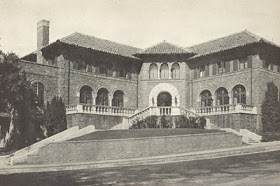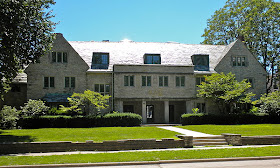At first glance, they might remind one of an English country home or perhaps an exurban estate in America. In actuality they are a kind of college dormitory with enhanced social areas that can assume any number of architectural guises from Georgian to Greek Revival to Tudor to Modernist, depending on location and when the structure was built.
The subject is American college fraternity and sorority houses. The Wikipedia entry on the so-called "Greek" system is here, but I'll present my own overview before turning you over to the photos.
College secret societies began appearing in America during the second quarter of the 19th century. Secret societies featuring initiation rites and rituals were nothing new even then, but became a fad to the point where one fraternity (Delta Upsilon) was founded using the Old Switcheroo marketing principle of being non-secretive.
Another feature of college fraternities was the use of Greek words as names. Since those names were part of the society's secrets, they were publicly known only by the Greek initials of those names.
The first fraternities were for male students. In the second half of the 1800s, female Greek-letter societies emerged; they are called sororities, though some of the earliest ones (such as my wife's Kappa Kappa Gamma) still officially refer to themselves as fraternities.
With the advent of sororities and the socially more relaxed 20th century, the secretive aspect of Greek-letter societies waned and the emphasis shifted to making student life more fun through partying and other activities. This is reflected in the architecture of the buildings that housed these societies. Originally, the societies existed only in ordinary student living quarters, but this soon shifted to wood-frame rooming-house style buildings or converted row-houses for colleges in large cities such as Boston, New York or Philadelphia.
As membership grew from fewer than 20 initiates around 1910 to 30 and more by 1920, more and more purpose-built houses appeared. The typical layout was study rooms and sleeping porches in floors above street level. A basement might include a recreation room, a furnace and utility room, and perhaps a room where the secret chapter meetings were held. The ground floor would contain the kitchen, dining room, a large living room useful for social events such as dances and receptions, and perhaps a small library or auxiliary living room.
Membership in Greek societies grew rapidly through the 1920s with chapter membership averaging 35-45 at major colleges. The Great Depression slowed growth and weeded out weak chapters on most campuses. World War 2 resulted in the temporary shutting down of many fraternity chapters, though sororities thrived. Fraternities experienced a postwar boom fueled by GI Bill money and the lack of alternative housing as the nation shifted from wartime scarcity to a peacetime economy. Once the postwar surge ebbed, average memberships dropped to 50s and 60s. The late 1950s and much of the 60s was another expansion period where many chapters built new houses or, more typically, expanded existing structures.
Greek systems at most campuses cratered in the late 60s and 1975s, weaker chapters again being forced to close. By the 1980s, membership roles increased, reaching upwards of 200 for some sororities on West Coast campuses -- though 100 members is more typical maximum. Fraternity membership tends to be more variable. At the University of Washington, for example, fraternity chapters range from 20 to 100 members, the average being around 55.
So that's the overview. Let's turn to the architecture.
Gallery
Zeta Psi fraternity, University of Michigan - before 1900?
This building from (perhaps) the 1890s seems to be an early example of a purpose-built house with fancy touches that take it a step beyond the rooming-house type of facility common on most campuses until the 1920s.
Phi Gamma Delta fraternity, University of California - 1928
Berkeley is on the northern fringe of California's Mediterranean climate zone, so the Fijis went for an Italianate style.
Phi Gamma Delta fraternity, University of Oklahoma
I don't know when this house was built, but the staging of the photo makes it look a lot like a motel.
Delta Delta Delta sorority, University of Georgia
This calm, colonial style house is appropriate for its Georgia location.
Delta Upsilon fraternity, University of Illinois - 1926
The University of Illinois has an interesting collection of Greek houses. Here is a Tudor style example with plenty of half-timbering.
Kappa Sigma fraternity, University of Michigan
An old photo; I don't know if the Kappa Sigs still use it. But it's a nice version of French Chateau architecture that would be more at home near the Loire than in Ann Arbor.
Phi Delta Theta fraternity, University of Illinois - 1922
Tudor style, but symmetrical, this Phi Delt house looks impressive in the photo.
Theta Xi fraternity, UCLA
Many fraternity and sorority houses at UCLA were constructed in the 1930s and featured a clean version of Spanish Colonial architecture appropriate to the Los Angeles area setting. Theta Xi is one of the first houses one encounters walking west from campus to Greek Row.
Sigma Kappa sorority, University of Washington
This Norman style building was where my daughter lived while at Washington.
Psi Upsilon fraternity, University of Washington
For some reason I always liked this Psi U house despite the half-timbering being on the verge of overdone.
Sigma Nu fraternity, University of Washington
This building dates back to around 1914, a surprisingly non-traditional style for its time.
Theta Chi fraternity, University of Washington
From the same architectural firm that did the Sigma Kappa house above.
Theta Xi fraternity, University of Washington
Built in 1926, this is where I lived as an undergraduate.













There's a rum tale about American art at Mr Sailer's site. What do you make of it?
ReplyDeletehttp://isteve.blogspot.com/
dearieme -- I thought the Surrender painting was a cute concept.
ReplyDeleteThe CIA funded stuff not mentioned in Sailer's post including, if I remember the right title, Paris Review.
As the material in the post suggests, funding certainly helped the artists in the sense of getting them increased publicity. Nothing said about actual purchases; did CIA money get laundered through key collectors? -- not likely, but possible.
Again, the enhancement of the cause of Abstract Expressionism was probably marginal. The New York School would have become dominant anyway because it was the logical outcome of previous trends that had stalled for a while between the wars. (I'm drafting a book on spec dealing with that; probably won't see the light of day ever).
As for the Cold War, I can't imagine any way the impact of this can be quantified, though it had to be a minor increment to awareness of Western cultural trends by Soviet intellectuals -- who had informal incluence as well as better access to information than the typical Russian. (And don't forget that the Sovs did their half of this cultural exchange thing, sending the Bolshoi west to do their dancing, etc.)
As the Saunders quote suggested, all it was was a bit more grease on the skids for an inevitability.
Whatever seems to be worry Steve doesn't worry me; there are far more important things to stew over these days.